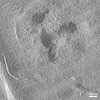[English] 日本語
 Yorodumi
Yorodumi- PDB-8s41: The structure of the copia retrotransposon icosahedral capsid (T=9) -
+ Open data
Open data
- Basic information
Basic information
| Entry | Database: PDB / ID: 8s41 | ||||||||||||||||||||||||||||||
|---|---|---|---|---|---|---|---|---|---|---|---|---|---|---|---|---|---|---|---|---|---|---|---|---|---|---|---|---|---|---|---|
| Title | The structure of the copia retrotransposon icosahedral capsid (T=9) | ||||||||||||||||||||||||||||||
 Components Components | Copia VLP protein | ||||||||||||||||||||||||||||||
 Keywords Keywords | VIRUS LIKE PARTICLE / Tomography / Drosophila / melanogaster / follicle cell / copia / Ty1 / retrotransposon / LTR | ||||||||||||||||||||||||||||||
| Function / homology |  Function and homology information Function and homology informationDNA polymerase complex / Hydrolases; Acting on peptide bonds (peptidases); Aspartic endopeptidases / DNA biosynthetic process / DNA integration / nucleic acid binding / aspartic-type endopeptidase activity / proteolysis / zinc ion binding / ATP binding Similarity search - Function | ||||||||||||||||||||||||||||||
| Biological species |  | ||||||||||||||||||||||||||||||
| Method | ELECTRON MICROSCOPY / subtomogram averaging / cryo EM / Resolution: 7.7 Å | ||||||||||||||||||||||||||||||
 Authors Authors | Klumpe, S. / Beck, F. / Briggs, J.A.G. / Beck, M. / Plitzko, J.M. | ||||||||||||||||||||||||||||||
| Funding support |  Germany, 1items Germany, 1items
| ||||||||||||||||||||||||||||||
 Citation Citation |  Journal: Cell / Year: 2025 Journal: Cell / Year: 2025Title: In-cell structure and snapshots of copia retrotransposons in intact tissue by cryo-ET. Authors: Sven Klumpe / Kirsten A Senti / Florian Beck / Jenny Sachweh / Bernhard Hampoelz / Paolo Ronchi / Viola Oorschot / Marlene Brandstetter / Assa Yeroslaviz / John A G Briggs / Julius Brennecke ...Authors: Sven Klumpe / Kirsten A Senti / Florian Beck / Jenny Sachweh / Bernhard Hampoelz / Paolo Ronchi / Viola Oorschot / Marlene Brandstetter / Assa Yeroslaviz / John A G Briggs / Julius Brennecke / Martin Beck / Jürgen M Plitzko /   Abstract: Long terminal repeat (LTR) retrotransposons belong to the transposable elements (TEs), autonomously replicating genetic elements that integrate into the host's genome. Among animals, Drosophila ...Long terminal repeat (LTR) retrotransposons belong to the transposable elements (TEs), autonomously replicating genetic elements that integrate into the host's genome. Among animals, Drosophila melanogaster serves as an important model organism for TE research and contains several LTR retrotransposons, including the Ty1-copia family, which is evolutionarily related to retroviruses and forms virus-like particles (VLPs). In this study, we use cryo-focused ion beam (FIB) milling and lift-out approaches to visualize copia VLPs in ovarian cells and intact egg chambers, resolving the in situ copia capsid structure to 7.7 Å resolution by cryoelectron tomography (cryo-ET). Although cytoplasmic copia VLPs vary in size, nuclear VLPs are homogeneous and form densely packed clusters, supporting a model in which nuclear import acts as a size selector. Analyzing flies deficient in the TE-suppressing PIWI-interacting RNA (piRNA) pathway, we observe copia's translocation into the nucleus during spermatogenesis. Our findings provide insights into the replication cycle and cellular structural biology of an active LTR retrotransposon. | ||||||||||||||||||||||||||||||
| History |
|
- Structure visualization
Structure visualization
| Structure viewer | Molecule:  Molmil Molmil Jmol/JSmol Jmol/JSmol |
|---|
- Downloads & links
Downloads & links
- Download
Download
| PDBx/mmCIF format |  8s41.cif.gz 8s41.cif.gz | 292.6 KB | Display |  PDBx/mmCIF format PDBx/mmCIF format |
|---|---|---|---|---|
| PDB format |  pdb8s41.ent.gz pdb8s41.ent.gz | 244.9 KB | Display |  PDB format PDB format |
| PDBx/mmJSON format |  8s41.json.gz 8s41.json.gz | Tree view |  PDBx/mmJSON format PDBx/mmJSON format | |
| Others |  Other downloads Other downloads |
-Validation report
| Arichive directory |  https://data.pdbj.org/pub/pdb/validation_reports/s4/8s41 https://data.pdbj.org/pub/pdb/validation_reports/s4/8s41 ftp://data.pdbj.org/pub/pdb/validation_reports/s4/8s41 ftp://data.pdbj.org/pub/pdb/validation_reports/s4/8s41 | HTTPS FTP |
|---|
-Related structure data
| Related structure data |  19708MC C: citing same article ( M: map data used to model this data |
|---|---|
| Similar structure data | Similarity search - Function & homology  F&H Search F&H Search |
- Links
Links
- Assembly
Assembly
| Deposited unit | 
|
|---|---|
| 1 | x 60
|
- Components
Components
| #1: Protein | Mass: 21400.764 Da / Num. of mol.: 9 / Source method: isolated from a natural source / Source: (natural)  Has protein modification | N | |
|---|
-Experimental details
-Experiment
| Experiment | Method: ELECTRON MICROSCOPY |
|---|---|
| EM experiment | Aggregation state: CELL / 3D reconstruction method: subtomogram averaging |
- Sample preparation
Sample preparation
| Component | Name: Copia retrotransposon capsid / Type: COMPLEX / Entity ID: all / Source: NATURAL |
|---|---|
| Molecular weight | Experimental value: NO |
| Source (natural) | Organism:  |
| Buffer solution | pH: 7 |
| Specimen | Embedding applied: NO / Shadowing applied: NO / Staining applied: NO / Vitrification applied: YES |
| Vitrification | Cryogen name: ETHANE-PROPANE |
- Electron microscopy imaging
Electron microscopy imaging
| Experimental equipment |  Model: Titan Krios / Image courtesy: FEI Company |
|---|---|
| Microscopy | Model: FEI TITAN KRIOS |
| Electron gun | Electron source:  FIELD EMISSION GUN / Accelerating voltage: 300 kV / Illumination mode: FLOOD BEAM FIELD EMISSION GUN / Accelerating voltage: 300 kV / Illumination mode: FLOOD BEAM |
| Electron lens | Mode: BRIGHT FIELD / Nominal defocus max: 5000 nm / Nominal defocus min: 3500 nm |
| Image recording | Electron dose: 3 e/Å2 / Avg electron dose per subtomogram: 120 e/Å2 / Film or detector model: FEI FALCON IV (4k x 4k) |
- Processing
Processing
| EM software |
| ||||||||||||||||||||||||||||||||||||
|---|---|---|---|---|---|---|---|---|---|---|---|---|---|---|---|---|---|---|---|---|---|---|---|---|---|---|---|---|---|---|---|---|---|---|---|---|---|
| CTF correction | Type: PHASE FLIPPING AND AMPLITUDE CORRECTION | ||||||||||||||||||||||||||||||||||||
| Symmetry | Point symmetry: I (icosahedral) | ||||||||||||||||||||||||||||||||||||
| 3D reconstruction | Resolution: 7.7 Å / Resolution method: FSC 0.143 CUT-OFF / Num. of particles: 735 / Symmetry type: POINT | ||||||||||||||||||||||||||||||||||||
| EM volume selection | Num. of tomograms: 3 / Num. of volumes extracted: 1780 |
 Movie
Movie Controller
Controller











 PDBj
PDBj